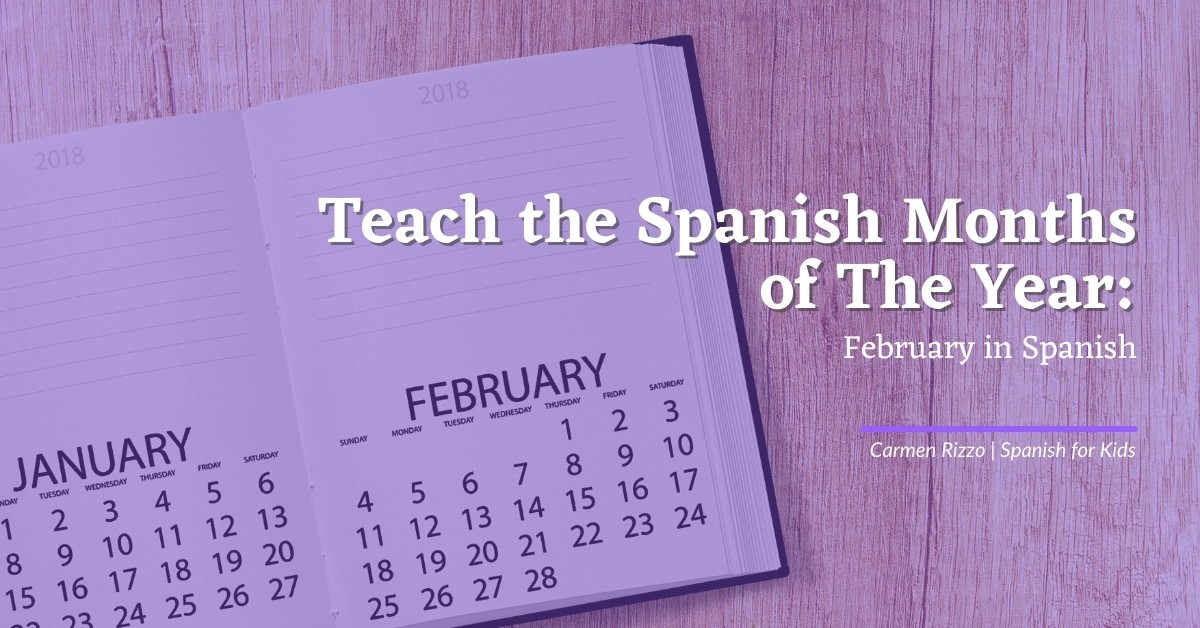
Teach Spanish Months of the Year: February in Spanish
February in Spanish is febrero, and not only is it the second month of the year but also the shortest!
During the time of the Romans there was a purification ritual called “februa,” which eventually evolved to February in English and febrero in Spanish.
January and February were the last two months added to the Roman calendar by the second Roman King, Numa Pompilius, because before him, Romans considered winter as a long season without months. Numa decided to add two more months to complete the calendar and adjust it to the lunar cycle.
February may be the shortest and most flexible month of the year, but is full of important events and celebrations. Let’s learn a little bit more about this amazing month and why it is so different to the other months of the year.
Why Does February Have 28 Days?
The original Roman calendar consisted of 10 months and it began in March and ended in December. But Numa Pompilius wasn’t happy about it because the 10 month calendar didn’t match with the 12 lunar cycles. So with the power he has as a king, he decided to add two more months: January and February.
But after adding them, he stumbled upon another problem: the year had an even number of days! And being a Roman, he knew that was bad luck. So while the other months had 29 or 31 days, he decided that for the year to have an uneven number of days February should be shorter.
Some people believe February was chosen to be the shortest month because during that month the Romans honored the dead and performed purification rituals. Because of that, February was the “unlucky” month.

Leap Year and Our Actual Calendar
Even if the intentions of Numa Pompilius were good when he added two more months to the Roman calendar, it was really inaccurate, so later a “leap month” was created. This leap month consisted of 27 days and was used when it was considered “necessary.”
It wasn’t until Julius Caesar got to power that he “fixed” the calendar. The months changed from being 29 or 31 days long to being 30-31 days. This made the calendar go from 355 days to 365.25 days, so to compensate for that extra time in the year, a “leap year” was established and that’s why February has 29 days every 4 years.
Here are some vocabulary words and phrases to talk about February in Spanish:
| Spanish | English |
| Febrero | February |
| El mes más corto del año. | Shortest month of the year. |
| ¿Por qué febrero es tan corto? | Why is February so short? |
| Porque así lo decidió un rey romano. | Because a Roman king decided it. |
| Año bisiesto | Leap year |
Celebrations During February in Spanish
Even if February is a short month, it is full of celebration and commemorations, here are some of the most popular and always mentioned celebrations when talking about February in Spanish in Latin America:
Día de Candelaria
This celebration is known as Candlemas in English, and is a popular Catholic celebration that commemorates the presentation of baby Jesus in the Temple after the purification of Virgin Mary. Also, in Spain, it commemorates the apparition of the Virgin in Tenerife.
In several places in Spain and Latin America, this festivity is celebrated through processions and masses to honor Virgin Mary. But many of the celebrations algo involve more communal activities.
For example, in the South of Spain, people tend to celebrate this event by igniting bonfires throughout the night, or lighting up candles in important places of the town, like plazas and schools.
In Mexico and other Latin American countries, during the Día de Candelaria families and friends get together to pray and to eat together. Tradition dictates that those who got a little plastic figurine of the Three Wise Kings or Baby Jesus while eating a rosca de reyes on January 6 have to prepare the food to eat on Día de Candelaria to share with those who celebrated with them Día de Reyes (Day of the Kings).
Día del Cariño/ Día de San Valentín
El día del Cariño o el día de San Valentín (Valentine’s Day) is a popular celebración Worldwide, and is considered a romantic celebration, but also a friendly one and is enjoyed by couples, family and friends.
To celebrate el día de San Valentín couples tend to go out to eat, to nature excursions or prepare romantic evenings with their special one. On this day it is normal to find restaurants and venues packed with couples since early morning and what are considered Valentine’s gifts, like flowers and chocolate normally duplicate their price during the days closer to the celebration.
On the other hand, single people, families and friends also celebrate Valentine’s Day but in a different way. A popular activity is to organise a gift exchange between friends and families, normally something inexpensive and get together to eat, make the exchange and enjoy some time together.
El día del San Valentín is so popular that some places sell thematic piñatas for the celebration, others sell special candy with love themes and some other places even have sales and discounts because of Valentine’s Day.
Black History Month
El mes de la Historia Negra or Black History month is an annual observance celebrated mainly in the United States, Canada, the United Kingdom and the Netherlands. It began as a way to remember important people and events that have marked the African and African-American community in history.
Even if it is mainly commemorated in North America and Europe, the Black History month has begun to gain notice in Latin America, thanks to the descendants of black people that live in these countries.
Beside the commemoration to famous black history figures and the remembrance of historical events that have marked the African-American communities in the continent, the Black History month is perfect to educate ourselves on the different life experiences of those around us and to learn about the richness of diversity.
Here is a short vocabulary to expand your fluency when talking about February in Spanish:
| Spanish | English |
| Día del Cariño / Día de San Valentín | Valentine’s Day |
| El chocolate | Chocolate |
| Las rosas | Roses |
| El arreglo floral | Flower arrangement |
| La pareja | Couple |
| La cita | Date |
| La velada romantica | Romantic evening |
| El intercambio de chocolates | Chocolate exchange |
| La amistad | Friendship |
| El compañerismo | Partnership |
| Afro-latinos | Afrolatino |
| Afro-americanos | African American |
| Los descendientes | Descendants |
| La cultura negra | Black culture |
| El respeto | Respect |
| La diversidad | Diversity |
Activities for February in Spanish
To celebrate the month of February there are several activities you can do, alone or with your friends and family, to practice your Spanish and get better at your fluency. Here are some ideas to do during February:
Learn popular refranes:
Los refranes are popular sayings that are transmitted orally by the people in Latin America. Most refranes are short phrases that give advice or transmit wisdom to those that hear them.
Here are some popular refranes to learn in February:
1. Abrígate por febrero con dos capas y un sombrero.
Cover in February with two layers and a hat.
2. Cuando no llueve en febrero no hay buen prado ni buen centeno.
When it doesn’t rain in February, there is not good meadow nor good rye.
3. En febrero un día malo y otro bueno.
In February, a good day and another bad.
4. En febrero un rato al sol y otro al romero.
In February a while in the sun and another in rosemary.
5. Cuando llueve en Febrero todo el año a tempero.
When it rains in February all year round at temperate.
Prepare chocolate hearts to give to your loved ones:
Almost everyone loves chocolate! And it is always a perfect gift for those we love. Preparing chocolate treats doesn’t have to be complicated, and this following recipe is the perfect example:
Ingredientes:
200 gramos de chispas de chocolate para cobertura color blanco
200 gramos de chispas de chocolate para cobertura color rosa
200 gramos de chispas de chocolate para cobertura color rojo
O
600 gramos de chispas de chocolate blanco
Colorante vegetal color rosa
Colorante vegetal color rojo
1 Molde de corazón para chocolates
Instrucciones:
En un recipiente apto para microondas coloca las chispas de chocolate que deseas derretir primero. Incerta por 20 segundos el recipiente con las chispas de chocolate al microondas, retira para moverlo, y calienta nuevamente. Repite el proceso hasta que el chocolate se funda.
Prepara el molde de los chocolates asegurándote que esté completamente seco. Puedes decorar el molde como tú quieras. Luego, toma el chocolate recién derretido y con ayuda de una cuchara llena el molde de los chocolates hasta el borde y da ligeros golpes al molde para explotar las burbujas de aire que podrían haber quedado.
Dejar reposar el chocolate por más de 10 minutos en la refrigeradora y desmoldar con cuidado.
Ingredients:
200 grams of white chocolate chips for coverage
200 grams of pink chocolate chips for coverage
200 grams of red chocolate chips for coverage
Or
600 grams of white chocolate chips
Pink food coloring
Red color food coloring
1 Heart-shaped chocolate mold
In a microwave-safe bowl, place the chocolate chips that you want to melt first. Insert the container with the chocolate chips in the microwave for 20 seconds, remove to move it, and heat again. Repeat the process until the chocolate melts.
Prepare the chocolate mold making sure it is completely dry. You can decorate the mold as you want. Then, take the freshly melted chocolate and with the help of a spoon, fill the mold with the chocolates to the brim and tap the mold lightly to explode any air bubbles that may have remained.
Let the chocolate rest for more than 10 minutes in the refrigerator and carefully unmold.
Learn More About February in Spanish!
February can be a cold and slow month, even when it is so short! So don’t let it get your mood down and get to practice your Spanish fluency to get better at talking about all the fun things to do in February! Sign up today for a free 1-on-1 class with a native Spanish speaker, and be part of all the students we have been reliably preparing in Spanish for more than 10 years!

Want more free Spanish lessons, fun content, and easy learning strategies for kids? Check these out!
- 7 Powerful Reasons Why Bilingualism in Children MattersPowerful Reasons Why Bilingualism in Children Matters
- Fall En Español: Exploring Autumn Activities for Kids
- Fun and Language: Spanish Playdates for Kids
- Milestone Moments: Tracking Kids’ Spanish Progress
- Building Blocks: Kid-Friendly Spanish Grammar
- Top 5 Spanish Grammar Games to Improve Your Language Skills
- Tips for Introducing Your Toddler to the Spanish Language
- 10 Spring Activities to Keep Your Elementary Students Busy
- An Easy Vocabulary Guide to Describe the Post Office in Spanish - February 10, 2023
- Guatemala’s Biggest, Most Colorful Market: Chichicastenango - December 28, 2022
- 8 Sad Spanish Songs for When Your Heart Is Broken - December 6, 2022




